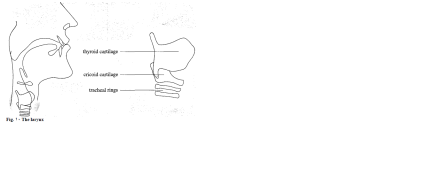The Larynx
Définition :
The Larynx is in the neck.Its main structure is CARTILAGE.Larynx is made up of two cartilages these cartilages are hollow and are attached to the top of the TRACHEA.When we breath the air passes through the trachea and the larynx. The front of larynx has Adam's Apple which is quite prominent in slim adults.Adam's apple is in fact a box which contains vocal folds which are made up of these two cartilages.

Définition : Vocal Folds
These are two thick flaps of muscles rather like a pair of lips, the ex-name for these is vocal cords.
At the front, the vocal folds are joined and fixed to the inside of the thyroid cartilage. At the back they are attached to a pair of small cartilages called the Arytenoid Cartilages so that if the arytenoid cartilages move the vocal folds move to.
The arytenoid cartilages are attached to the top of the Cricoid cartilage, but they can move so as to move the vocal folds apart or together. We use the word glottis to refer to the opening between the vocal folds.
If the vocal folds are apart we say that the glottis is open, if they are pressed together we say that the glottis is closed.
Different positions of Vocal Folds
Wide Apart: | Narrow Glottis | Position for vocal fold vibration | Vocal folds tightly closed |
|---|---|---|---|
The vocal folds are wide apart for normal breathing and usually during voiceless consonants like p, f, s. | If air is passed through the glottis when it is narrowed, the result is a fricative sound for which the symbol is /h/. The sound is not very different from a whispered vowel. | when the edges of vocal folds are touching each other are nearly touching, air passing through the glottis will usually cause vibration. | We call this position a glottal stop or glottal plosive, and for this we use the symbol /?/.it can be practised by coughing gently ; then practise the sequence ahahahah. |

Respiration and Voicing
When air is moved out of the lungs we say there is an egressive pulmonic air stream.We obstruct the air flow by articulators.We form strictures in the vocal tracts.If the vocal folds are apart there will be no vibration, thus no voicing will take place.But if the vocal folds are intact there will be voicing and vibration.
Different variations in the vocal folds for different voicing.
Variations in intensity: We produce voicing with high intensity for shouting, for example, and with low intensity for speaking quietly.
Variations in Frequency: If the vocal folds vibrate rapidly, the voicing is at high frequency; if there are fewer vibrations per second the frequency is lower.
Variations in Quality: We can produce different sounding voice qualities, such as those we might call harsh, breathy, murmured, or creaky.






